Menus
- R6, Wind and Fire
- Discovery
- Technical
- In the saddle
- In the city
- Motorway and expressways
- Departmental
- Part-cycle
- Braking
- Comfort / Duo
- Consumption
- Conclusion
- Colors
R6, Wind and Fire
With multiple sporting origins, such is the Yamaha R6, drawing its roots from different family branches of the segment. Thus, at the beginning was the FZR 600 cm3 of 1989, revolutionary in its time and designed for the Supersport championship: DeltaBox frame and 4 inclined cylinders with 16 valves. It produces 90 hp at 10,500 rpm for 179 kg dry.
5 years later, a new FZR 600 R was inspired, in part, by the YZF 750 R racing machine. But the latter had a Genesis-type 749 cm3 in-line four: five valves per cylinder and exhaust valve " Exup "to improve power at low and medium revs. The ultimate descendant of the ex-FZR is made with a road-sport evolution, the YZF 600 R Thundercat from 1996. Far from the mechanical tsunami to come.
A decade after the first 600 therefore appears a whole new generation, the Yamaha YZF R6, introducing the current surname. 120 hp at 13,000 rpm, 6.94 da.Nm at 11,500 revolutions for 169 kg dry, ultra-compact aluminum frame and race geometry. A number of improvements characterize the 2003 opus, including a new die-cast frame, injected intake and reduced weight to 162 kg. The 2005 model continues this arms race with inverted fork, larger diameter brake disc with radial calipers, engine upgrades and anti-dribble clutch.
Aesthetically, the 2006 machine has made a clean sweep of curves, letting its hyper-sport character exude externally. Angles to take an angle, taut lines to catch the points of strings, a face to the Batman and a red zone to…. 17,500 rpm! But less in real life. World first Ride by Wire accelerator and 127 hp make this model a benchmark. The beauty then evolves more slowly, very slightly reducing its physical and mechanical excesses without fundamentally denying its infatuation with high speeds. And then..? A few things. In fact, 7 years of waiting for a renewal.
Yamaha therefore finally offers its new YZF-R6 in 2017. This latest generation sports ballerina benefits from the development of its predecessor, the latest YZF-R1. In the program? Sport, sport and…. yes, sport !
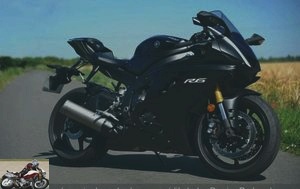
Discovery
Unrecognizable, very close to that of its big sister of 999 cm3, the aesthetics of the YZF-R6 2017 is a success. She also has little to envy him, outwardly. Less muscular, its silhouette retains an unusual finesse and elegance. It seems to borrow certain details of the style of its front face from a few recent Italians. The whole is so homogeneous that we barely notice the front air inlet. Ultra-compact, the little Japanese racing girl has a very slender look. Thin blades of LEDs make up its daytime running lights, supplemented by two more imposing road lights, hidden under the fork crown. The lines then stretch towards the sides in taut curves but without excess, enveloping the machine in sculpted fairings with discreet shapes..

This fluid dress is dominated by the faceted volumes of the tank. Made of aluminum, lightened by 1.2 kg, the 17-liter container receives ventilation slots for the electronics. Much more hollowed out at the knees, its sides leave all the more space for the pilot to move. A recess at its top awaits your helmet when you lie down there to escape the high speed flows ….
And the pilot seat seems to leave the necessary space for this dab position, dominated by the passenger seat in single format. Made from die-cast magnesium, the narrower 20mm rear buckle is arguably the YZF-R6’s most notable design element. Solid in the lower part, the frame spars are then refined into two sheets forming fins then sheathed in plastic, creating a sharp stern. A blade of diodes hangs vertically to the whole and the whole produces a dynamic effect leaving a strong impression.

The overall finish is generally rewarding except for a few cables and electrical plugs present in particular in the fork crown. Likewise, the protective foam blocks on the inside of the fairings are a bit surprising. But it is above all the exhaust that raises questions and whose aesthetics are totally unworthy of this type of machine. We console ourselves with mirrors with easily retractable and adjustable metal uprights, integrating LED turn signals. Diodes which also equip the entire machine. Finally, beware of the slender side stand, very vertical, which can easily be disengaged ….
Technical
Surprisingly, part-cycle and engine evolve very little. The new pocket sports tuning fork still rests on an aluminum Deltabox frame surrounding the 599 cm inline four cylinder³, with double overhead camshaft and four valves per cylinder. Few developments there too. Super square, the unchanged bore x stroke ratio of 67.0 x 42.5 mm still favors high, very high speeds. Maximum power is thus reached at 14,500 rpm, releasing 118.4 hp (87.1 kW) and engine force 6.17 da.Nm at 10,500 revolutions. Always high rotation values. The gear ratios remain identical but the Yam ‘is fitted with a standard quick shifter. Subject to the yoke of Euro4 standards, performance drops slightly by 5 hp and 0.3 da.Nm. But the beautiful parts are always there, with valves and exhaust line in titanium and Exup valve.
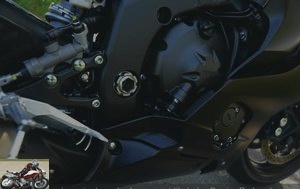
The 2017 vintage is more electronic and integrates 3 Yamaha D-Modes, Standard, A and B, managing the engine maps. The system modulates the response to the grip without reducing power. On B, the raises are smooth, ideal in case of poor grip. In contrast, mode A makes the machine jump at the slightest flick of the wrist. The R6 receives a traction control which can be set to 6 values and can be switched off (TCS). The whole is driven by the Ride by Wire accelerator (YCC-T). In addition, the mechanics benefit from the YCC-I, Yamaha’s electronic variable intake control system and the clutch is anti-dribble..
No evolution either in geometry whose wheelbase, 1375 mm, the column angle, 24 ° and the caster, 97 mm remain identical. The same goes for the swing arm. The equipment manufacturer Kayaba signs the suspensions. Borrowed from the R1, the fork sleeves go from 41 to 43 mm for a travel of 120 units. The element is adjustable in all directions, like the shock absorber.
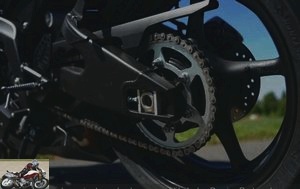
To stop the flyweight athlete, two opposing 4-piston monobloc radial callipers attack 320mm discs at the front. The opposite single piston retarder grips a 220mm freight. Everything is under the control of the non-deactivatable ABS, managing the rotation of the five-spoke aluminum alloy rims, devoid of angled valves. They receive Dunlop Sportsmart or Bridgestone S21 envelopes in 120 and 180 mm.
In the saddle
If the hyper compact size of the Yamaha YZF-R6 can put off the biggest, the space on board is very correct, for the category of course. Top model on stiletto heels, the YZF-R6 maintains a saddle height of 850 mm BUT sees its crotch reduced by 20 units, significantly improving access to its backbone. We also note a possible very significant decline in the saddle, with almost 20 cm of amplitude! Almost two seats in one.
Of course, sport is invited at all levels. High and back, the controls bend the legs and strongly tilt the bust on the bracelet half-handlebars themselves placed very low. The athlete does not suffer from any compromise. You wanted war, it is your weapon and the first victims are your wrists. I will also be so surprised by taking back my BMW R1100S by its height and comfort, that I will think for a moment that Yamaha had played a trick on me and transformed my machine into a trail runner ….
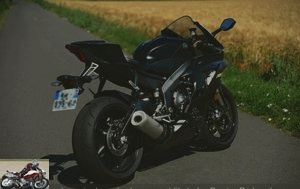
Before your eyes, the expression is perfect, the top tee done in minimalism. This sobriety does not forget an appreciable finish, the fine black granite of its surface contrasting with the bright colors of the fork caps. These support the hydraulic adjustments and preload of the steering gear. TCS and D-Mode are adjusted to the left and right stalk by dedicated pushbuttons and the brake lever is adjustable in spacing.
We are less enthusiastic about the cockpit which could be better sheathed as well as on the instrument cluster inherited from the 2015 generations. A large analog tachometer (note the R6 for the 6,000 revolutions….) Overhung by the shiftlight lamp and s’ adjoins a large digital window. The latter includes tachometer, gear indicator engaged, engine or air temperature, TCS adjustment level, selected driving mode and clock. A push-button on the dashboard then scrolls through the odometer and two partials, each with instantaneous or average consumption and mileage count of passage in reserve.

In the city
A quick burst from the starter launches the four-cylinder into a quiet hiss. But the first acceleration makes the airbox speak, resonating as soon as the tachometer passes 5,000 revolutions. However, the first 7000 increments seem useless as the engine seems absent. Fortunately, with nearly 16,000 usable revs, the R6 still has plenty under the handle ….
Flexible, the mechanics allow to evolve to the legal on the highest reports. This softness contrasts with a selection that is not very attractive. Rough, it is hardly pleasant, especially when downshifting, but my test machine did not have 1000 km…. To have. We will appreciate more to shift gears to the shifter on the boulevards, so regretting that the downshift is not provided.
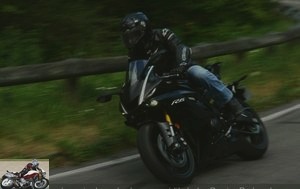
The extreme position requires a little getting used to in built-up areas. Steering seems hard at first, but it’s up to the pilot to indicate the direction by any means. Once this subtlety is integrated, the R6 is a lively companion. However, that doesn’t change its turning circle, which is one of the largest in production. Donkey hat for half-turns. Whatever, shopping for sports is not a reasonable choice. Fortunately, its weight of 190 kg ready to roll puts the difficulties of maneuvers into perspective..
Between the walls, the R6 quickly shows the limits inherent in this type of machine. In addition, the boiler heats up strongly and struggles to evacuate the calories elsewhere than on its pilot. Two fans are not too many…. Not very comfortable, the position is especially less convenient for reacting in an emergency. The weak lever arm befits piloting on the track but hardly the vagaries of urban travel. We get used to it but the mechanics also pushes too often to excess…. The YZF wants the R, direction the rectilinear horizon.
Motorway and expressways
A breath, a metallic roar, the Yam ‘sucks the landscape in its cyclopean air inlet. The shiftlight flashes all the time and the license flies like the tachometer needle towards the red zone…. Ah, but…. it sends this thing! Zero mechanical inertia, reduced weight and aeronautical aerodynamics propel the crew towards high speeds. After 10,000 rpm, the tuning forks block is furious and reminds us of this character so specific to the 600 four cylinders. Everything in the towers. I take advantage of the immense recoil offered by the saddle and use the release of the tank to wedge my helmet there. 50mm taller, the new screen offers very good protection and excellent vision. Much better than some 1000…. And the stability is excellent.
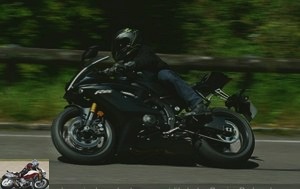
In legal terms, we are moving at 7,200 rpm on the last report. Perfect for effective times, but better if you enter a speed. Almost free from vibration, the machine purrs and pushes to leave the radar-equipped expressways. Anyway, we had covered the question and the answer: the YZF-R6 was born for speed. But what about its handling on the road??
Departmental
Care should be taken to choose roads with the correct pavements. Failing this, the racing profile of the suspensions is painful on uneven asphalt. That detail aside, the R6 is a scalpel for drawing curves. Precise, lively, the Yamaha reacts to the slightest impulses, setting its trajectory on the eyes of the pilot. Its low weight is its first quality, limiting frame movements and reducing the effort to take hypersport. In small corners, this compensates for a geometry less favorable to pins. The R6 shifts from angle to angle in an intuitive rocking motion but less natural than on a roadster of course. But when the layout loosens, the Japanese woman makes the fire of her turbine speak and her stability on the angle. On condition of maintaining the missile thruster at more than 8,000 turns. Below, the block is weak or sluggish. A 600 four-cylinder requires following the instructions to get the most out of it. And then reward you with an unparalleled mechanical orgy. It then takes a lot of horses on a more consistent machine to hope to beat him the pawn. Especially since the handling of the front axle is one of the best, transmitting a lot of information to the pilot.
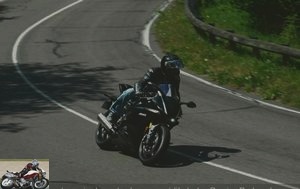
The mechanical vigor of the Yam ‘may come as a surprise to many, despite an average engine power. Very present, the sound of the airbox highlights the mechanical force more than the sound of the exhaust. It is in Standard mapping that the machine is the most predictable, avoiding the jolts of mode A (sporty). Precise, the accelerator allows you to dose the gas to the millimeter, especially in bends, ideal for re-accelerating with confidence.
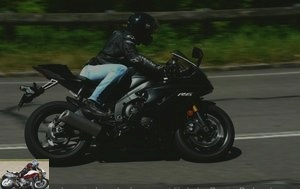
Here again, the reduced weight plays a big role, as does the braking phases and the Yamaha makes the most of its top-of-the-range suspensions. Progressive, the fork works remarkably at the start and at the end of the race, limiting mass transfers. And on the raises, the shock absorber stalls the machine without parasitic movement. Finally, only the slightly dry selection reminds the pilot on downshifting. We will console ourselves with enduring and powerful braking, perfectly dosable.
The dynamics are perfectly supported by a fast gearbox and a precise shifter. Likewise, Dunlop Sportsmart tires put the 600’s cavalry into confidence and easily collect it..
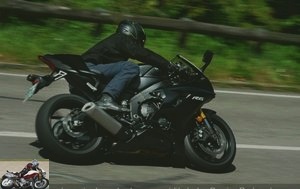
Part-cycle
Equipped with very good suspensions, the YZF-R6 benefits from a lively geometry and a contained weight, making it a first class choice for those who want an efficient machine. Adjustable in all directions, the suspensions will follow the pilot’s wishes and needs, both on the track and on the road.
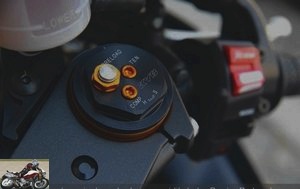
Braking
Powerful, the front calipers deliver decelerations under control. With its radial master cylinder, the lever allows you to best adjust the desired force. The rear clamp perfectly supports the steering gear, allowing the R6 to be seated at will when cornering. Finally, the ABS is triggered only wisely and with great neutrality, without straining a sporty steering..
Comfort / Duo
Competition saddle, suitable position…. relax by screwing the throttle on circuit. Comfort then no longer makes sense.
The R6 has passenger footrests allowing, of course, to withstand a possible nuisance, but above all to pass the straps of a saddle bag! Who said hyper-sport isn’t practical? It is indeed the only possible baggage because the aluminum tank, preceded by a plastic cover, will not be able to support a magnetic tank bag…. And don’t expect to secure it with straps; between the impossibility of sliding them and the heat of the boiler…. you will choose a backpack !
Attention, the lighting in bends can surprise. The leds produce a very marked beam, which is reduced to very little on the inside of the bend, leaving only shadow.
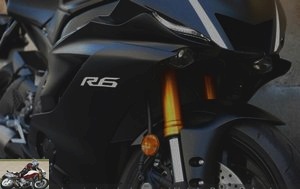
Consumption
An average of 6.5 liters in the mixed cycle suggests the sportiness of the block. Choosing D-mode B quenches Yam’s thirst. In normal use, 180 km of autonomy is the norm.
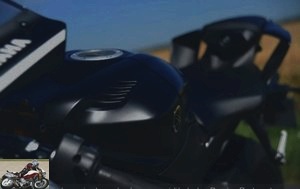
Conclusion
The last representative of a once dynamic segment, the Yamaha YZF-R6 remains an exceptional machine, cut out for sporting performance. Its daily use requires sacrifices but allows you to enjoy an addictive and rewarding machine. Quality of components, mechanics and geometry prove the outcome of this exclusive model.
However, this high-flying achievement at a rate of the same type: € 13,999.00…. This may seem excessive in view of reduced use and only makes sense on the track. The Yamaha YZF-R6 is a diamond, for lovers of machines with pure efficiency and without compromise.

Strong points
- Aesthetic
- High speed engine character
- Anti-dribble clutch
- Electronic
- Braking
- Sound
- Protection for the segment
Weak points
- Aesthetics of unworthy silencer
- No angled valves
The technical sheet of the Yamaha YZF-R6
Colors
- Candy Lime Green (green) / Metallic Carbon Gray (gray)
- Metallic Spark Black (black) / Metallic Graphite Gray (gray)
- Candy Burnt Orange (orange) / Metallic Carbon Gray (gray)
Related articles
-
200 hp at 13,500 rpm, 112 N.m at 11,500 rpm, 199 kilos with full fuel, from € 18,499 Is the Crossplane engine an advantage in road use ? Even if the…
-
New re-evolution High-end road symbol of the manufacturer with tuning forks, the FJR 1300 descends from a long line of dynamic travelers. The first of…
-
Yamaha XT 1200 Z Super Tenere motorcycle test
The return of a legend XT … the magic code! Tenere … the breath of adventure …. Driven by the greatest pilots of rally raids like the Dakar, the…
-
Yamaha Tracer 700 GT motorcycle test
Joys of possibilities Twin-cylinder in-line, 689 cm3, 74.8 hp, 68 Nm, 200 kg all full, available in A2, 8,999 euros. The Yamaha Tracer 700 Gt! Here is a…
-
Sport Heritage or the standard garage-style motorcycle Fashion is retro and hype, with in particular the multiplication of events such as Bike Shed or…
-
Roadster Sport-Heritage Fasters Sons Following on from the XSR 700, Yamaha today unveils its new Sport-Heritage XSR 900 roadster in dynamic fashion….
-
Trace strong and far The impressive commercial success of the Yamaha MTs is a quantified reality: 3,700 MT-09 (including 15% of Street Rallye and Sport…
-
The bête noire of conformism 3 cylinders in line, 889 cm3, 119 hp and 93 Nm, 189 kg, 9,499 euros With its MT-09, Yamaha revolutionized the market for…
-
Upgrading Unchanged since 2012, the Yamaha 450 WRF has this time been completely revisited. Derived from the excellent YZF cross model, this new Yamaha…
-
Fashion victim ! The single-cylinder trail is out of fashion and that’s a shame. Because the Yamaha XTZ 660 Tenere remains the embodiment of the…